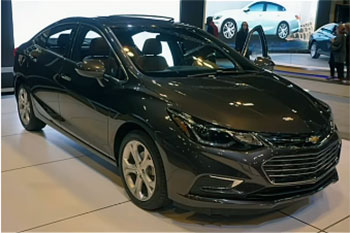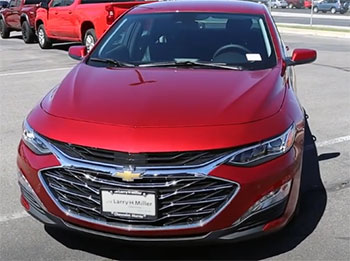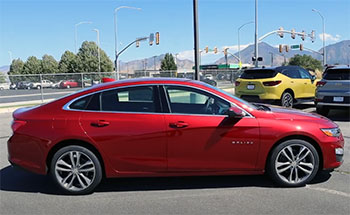I’ve always been a fan of Chevrolet’s reliable, stylish sedans, so when I needed to choose between the compact Cruze and the midsize Malibu for my next car, I knew I had a tough decision ahead. Both vehicles have their strengths, but they cater to different needs and lifestyles.
In this article, I’ll share my firsthand experience driving and researching these two models, comparing their performance, features, and practicality to help you decide which Chevy sedan suits you best. From fuel efficiency to interior space, I’ll break down what makes each car shine and where they fall short.
Comparison Table: Chevrolet Cruze Vs. Chevrolet Malibu
| Feature | Chevrolet Cruze | Chevrolet Malibu |
|---|---|---|
| Class | Compact sedan/hatchback | Midsize sedan |
| Base Price (2019) | $17,995 | $22,090 |
| Base Engine | 1.4L Turbo 4-cylinder, 153 hp | 1.5L Turbo 4-cylinder, 160 hp |
| Fuel Economy (city/hwy) | 28/38 mpg (sedan, gas) | 29/36 mpg |
| Passenger Volume | 94 cu. ft. | 102.9 cu. ft. |
| Cargo Volume | 14.8 cu. ft. (sedan), 47.2 cu. ft. (hatchback) | 15.7 cu. ft. |
| Infotainment | 7-inch touchscreen, Apple CarPlay/Android Auto | 8-inch touchscreen, Apple CarPlay/Android Auto họ |
| Safety Features | 10 airbags, Teen Driver, optional Lane Change Alert | 10 airbags, Teen Driver, optional Adaptive Cruise Control |
| Highway Range | 521 miles | 569 miles |
| Trim Levels (2019) | L, LS, LT, Premier, Diesel | L, LS, RS, LT, Hybrid, Premier |
My Experience With the Chevrolet Cruze
When I first slid into the driver’s seat of a 2019 Chevrolet Cruze LT, I was struck by how nimble and approachable it felt. As a compact sedan, it’s designed for folks like me who want something easy to maneuver in tight city streets but still capable of holding its own on a highway road trip.
The Cruze’s exterior has a sleek, modern vibe, though I’ll admit its styling feels a touch dated compared to some competitors like the Honda Civic. Still, its compact size made parking a breeze, especially in crowded urban lots where every inch counts.

The Cruze’s interior surprised me with its roominess for a compact car.
With 94 cubic feet of passenger space, I could comfortably seat four adults, though the rear seats felt a bit snug for taller passengers on longer drives.
The hatchback version, which I also tested, was a game-changer for cargo space, offering up to 47.2 cubic feet with the rear seats folded down.
I tossed in a week’s worth of groceries, a couple of duffel bags, and even a small bike without breaking a sweat. The sedan’s trunk, at 14.8 cubic feet, was less impressive but still practical for daily needs.
Under the hood, the Cruze’s standard 1.4-liter turbocharged four-cylinder engine pumped out 153 horsepower, which felt peppy enough for city driving. Merging onto highways required a bit more patience, but the smooth six-speed automatic transmission made up for it.
The diesel option, a 1.6-liter turbodiesel with 137 horsepower and 240 lb-ft of torque, was a standout for efficiency, delivering an impressive 31/48 mpg city/highway. I averaged about 38 mpg on a mixed commute, which kept my gas station visits to a minimum. The Cruze’s handling was responsive, with a tight turning radius that made navigating twisty roads fun, though it’s no sports car.
Tech-wise, the Cruze’s 7-inch touchscreen infotainment system was intuitive, with Apple CarPlay and Android Auto coming standard. I connected my phone in seconds and streamed my favorite playlists effortlessly. The Teen Driver system, which lets parents set speed and audio limits, was a neat feature I wish I’d had when teaching my younger sibling to drive. Safety features like 10 standard airbags and a rearview camera gave me peace of mind, though advanced options like Lane Change Alert were only available on higher trims.
Overall, driving the Cruze felt like slipping into a reliable, budget-friendly companion. It’s not flashy, but it gets the job done with a focus on efficiency and practicality. For someone like me, who values affordability and ease of use, the Cruze was a strong contender.
Pros Of the Chevrolet Cruze
- Affordable starting price: The 2019 Cruze starts at just $17,995, making it one of the most budget-friendly options in its class. It’s a great choice if you’re looking to save without sacrificing quality.
- Impressive fuel economy: With up to 28/38 mpg (gas) and 31/48 mpg (diesel), the Cruze stretches every gallon, perfect for long commutes or road trips.
- Hatchback versatility: The hatchback model offers 47.2 cubic feet of cargo space, rivaling some crossovers. I easily fit camping gear and sports equipment for weekend getaways.
- User-friendly technology: The 7-inch touchscreen, paired with Apple CarPlay and Android Auto, made navigation and entertainment seamless. I loved how quickly it responded to inputs.
- Compact maneuverability: Its small footprint made parking and city driving a breeze, especially in tight spaces where larger sedans struggle.
- Diesel engine option: The 1.6-liter turbodiesel engine delivers excellent torque (240 lb-ft) and highway efficiency, ideal for those prioritizing fuel savings.
- Strong safety ratings: With 10 airbags and a 4.51/5 NHTSA safety rating, the Cruze felt secure, especially for new drivers or families.
The Cruze’s affordability was a huge draw for me. At nearly $4,000 less than the Malibu’s base price, it left room in my budget for extras like a road trip or a new sound system. The diesel engine option was a rare find in the compact class, and I appreciated how it balanced power with efficiency. I clocked a 500-mile road trip without needing to refuel, which was a pleasant surprise. The hatchback’s cargo space was a lifesaver for my active lifestyle, letting me haul everything from gym bags to IKEA hauls. The tech, while not cutting-edge, was straightforward and reliable, and the safety features gave me confidence on busy highways. For a single driver or small family, the Cruze offers a lot of bang for your buck.
Read More: My Thoughts On Acura MDX Vs. Jeep Grand Cherokee
Cons Of the Chevrolet Cruze
- Cramped rear seating: The rear seats, with 36.1 inches of legroom, felt tight for taller passengers. My 6-foot friend complained after a 30-minute ride.
- Underpowered base engine: The 153-hp 1.4-liter engine was fine for city driving but lacked punch for quick highway merges or passing.
- Dated exterior styling: Compared to sleek competitors like the Honda Civic, the Cruze’s design felt a bit uninspired, like it was stuck in the early 2010s.
- Limited advanced safety features: Features like Lane Keep Assist were only available on higher trims, which bumped up the price significantly.
- Discontinued model: Chevy stopped making the Cruze after 2019, so parts availability could become an issue down the road, which worried me for long-term ownership.
- Basic interior materials: The cabin used a lot of hard plastics, which felt cheap compared to the softer materials in rivals like the Mazda3.
- No hybrid option: Unlike the Malibu, the Cruze lacks a hybrid powertrain, limiting options for eco-conscious buyers.
The Cruze’s rear seat was a letdown when I had friends along for a group outing. Anyone over 5’10” struggled to get comfortable, and long drives amplified the issue. The base engine, while efficient, left me wanting more power when I needed to overtake on the highway. I also found the exterior a bit bland—it didn’t turn heads like some competitors. The lack of standard advanced safety features was frustrating, especially since I had to shell out for a higher trim to get them. Knowing the Cruze was discontinued gave me pause about future maintenance costs, and the interior’s plasticky feel didn’t scream “premium.” It’s a solid car, but it’s not without flaws.
My Experience With the Chevrolet Malibu
The 2019 Chevrolet Malibu LT felt like a step up the moment I got behind the wheel. As a midsize sedan, it’s noticeably larger than the Cruze, with a more imposing presence on the road. Its sleek, aerodynamic lines and bold grille gave it a sophisticated edge that caught my eye immediately. Driving through suburban streets, I felt a sense of confidence that the Cruze’s compact frame didn’t quite match. The Malibu’s size made it feel like a family car, but it was still agile enough for daily commutes.

Inside, the Malibu’s 102.9 cubic feet of passenger space was a revelation. I had no trouble fitting five adults, with 38.1 inches of rear legroom that kept everyone comfortable, even on a two-hour drive to the coast.
The 15.7-cubic-foot trunk swallowed up luggage and beach gear, though it didn’t match the Cruze hatchback’s versatility.
The cabin felt more upscale, with premium cloth upholstery and an 8-inch touchscreen that looked sharper than the Cruze’s 7-inch display. The steering wheel-mounted controls were a nice touch, making it easy to adjust settings without taking my eyes off the road.
The Malibu’s standard 1.5-liter turbocharged four-cylinder engine delivered 160 horsepower, just a smidge more than the Cruze. It felt smoother during highway merges, and the continuously variable transmission (CVT) was seamless, though not as engaging as a manual.
The hybrid option, with 49/43 mpg city/highway, was tempting for its fuel savings, but I stuck with the gas model, which averaged 29/36 mpg. The ride was plush, soaking up bumps better than the Cruze, making it ideal for long drives. MotorTrend’s review called it “stylish” and “roomy,” and I couldn’t agree more—it felt like a great daily driver.
The Malibu’s tech matched the Cruze’s, with Apple CarPlay, Android Auto, and a 4G LTE Wi-Fi hotspot. But it went further with available features like Adaptive Cruise Control and a sunroof, which added a touch of luxury. Safety-wise, it offered 10 airbags and Teen Driver technology, though its NHTSA rating of 4.30/5 was slightly lower than the Cruze’s. Optional features like Lane Change Alert with Side Blind Zone Alert made highway driving less stressful.
The Malibu felt like the grown-up choice—spacious, refined, and versatile. It’s perfect for families or anyone craving a bit more room and comfort, though its higher price tag reflected that.
Pros Of the Chevrolet Malibu

- Spacious interior: With 102.9 cubic feet of passenger space and 38.1 inches of rear legroom, the Malibu comfortably fits five adults for long trips.
- Smooth ride quality: The suspension absorbed road imperfections better than the Cruze, making it ideal for highway cruising or rough city streets.
- Hybrid option available: The Malibu Hybrid’s 49/43 mpg city/highway appealed to my eco-conscious side, offering great savings at the pump.
- Larger infotainment screen: The 8-inch touchscreen was crisp and responsive, elevating the cabin’s tech-forward feel.
- More powerful base engine: The 1.5-liter turbo’s 160 horsepower provided better acceleration than the Cruze, especially for highway driving.
- Upscale interior touches: Premium cloth and available leather seats gave the Malibu a more refined feel than the Cruze’s plasticky cabin.
- Advanced safety options: Features like Adaptive Cruise Control and Lane Keep Assist were available, adding confidence on busy roads.
The Malibu’s interior was a highlight for me. I could stretch out, and my passengers never complained about legroom, even on extended drives. The smooth ride made my daily commute feel less taxing, and the hybrid option was a big draw when gas prices spiked. The larger touchscreen and extra tech features, like the available sunroof, made the cabin feel modern and inviting. The slightly more powerful engine gave me the confidence to merge onto highways without hesitation. For families or anyone who values comfort and space, the Malibu delivers a premium experience at a reasonable price.
Cons Of the Chevrolet Malibu
- Higher price point: Starting at $22,090, the Malibu costs significantly more than the Cruze, which could stretch budgets for some buyers.
- Lower resale value: The Malibu loses 43.7% of its value over five years, compared to the Cruze’s 40%, per iSeeCars data.
- No hatchback option: Unlike the Cruze, the Malibu only comes as a sedan, limiting cargo versatility for bulky items.
- Slightly lower fuel economy: At 29/36 mpg, the gas-powered Malibu trails the Cruze’s 28/38 mpg, especially on highways.
- Discontinued model: Like the Cruze, the Malibu was discontinued after 2024, raising concerns about future parts availability.
- Less agile handling: The larger size made the Malibu less nimble in tight spaces compared to the Cruze’s compact frame.
- Lower safety rating: Its 4.30/5 NHTSA rating is slightly below the Cruze’s 4.51/5, which might matter to safety-focused buyers.
The Malibu’s price was a sticking point for me. It’s nearly $4,000 more than the Cruze, which made me question whether the extra space and features were worth it. The lack of a hatchback option was a bummer, especially after experiencing the Cruze’s cargo flexibility. Fuel economy, while decent, didn’t match the Cruze’s efficiency, and the discontinued status gave me the same long-term maintenance worries. The Malibu felt a bit cumbersome in tight parking lots, and its slightly lower safety rating was a minor concern. It’s a great car, but it demands a bigger investment.
Read More: My Thoughts On Acura MDX Vs. Volvo XC90
Frequently Asked Questions (FAQ)
Chevy discontinued the Cruze after 2019 due to declining demand for compact sedans as consumers shifted toward SUVs and crossovers. The company focused on more profitable models like the Equinox and Blazer.
The Malibu was discontinued after 2024 as part of Chevy’s pivot away from sedans to focus on SUVs, trucks, and electric vehicles, reflecting market trends and higher profit margins in those segments.
Yes, the Cruze is a solid choice for budget-conscious buyers seeking fuel efficiency and compact versatility, but its discontinuation may pose challenges for parts and resale value.
The Malibu is worth it for those needing a spacious, comfortable sedan with modern features, though its higher price and lower resale value are factors to consider.
Conclusion: For Chevrolet Cruze and Malibu
After spending time with both the Chevrolet Cruze and Malibu, I can say they’re both fantastic sedans, but they cater to different needs. If you’re like me—someone who values affordability, fuel efficiency, and maneuverability—the Cruze is your go-to. Its compact size, impressive mpg, and hatchback option make it perfect for singles or small families on a budget. But if you need more space, a smoother ride, and a touch of luxury, the Malibu is the better pick. Its roomy interior and upscale features suit families or long-distance commuters. Whichever you choose, you’re getting a reliable Chevy that balances practicality and style. Take a test drive and see which one feels like home for you.

